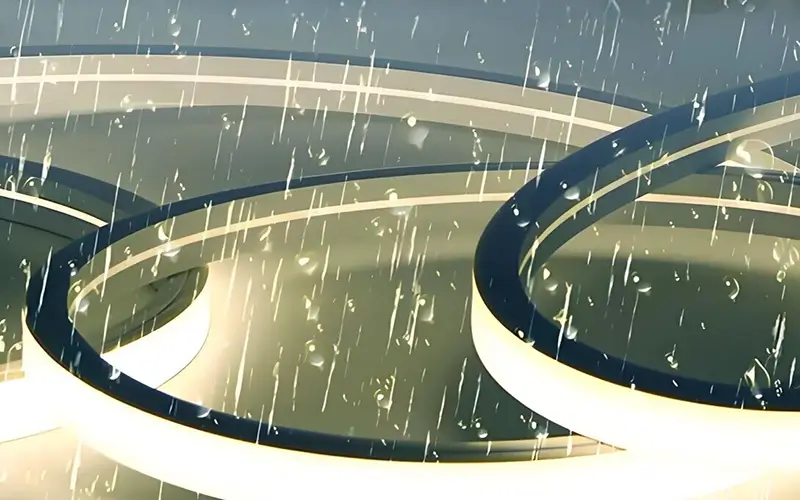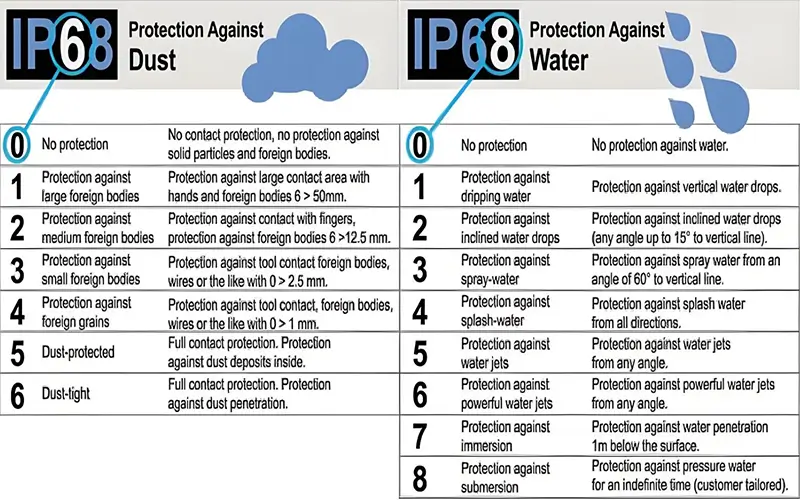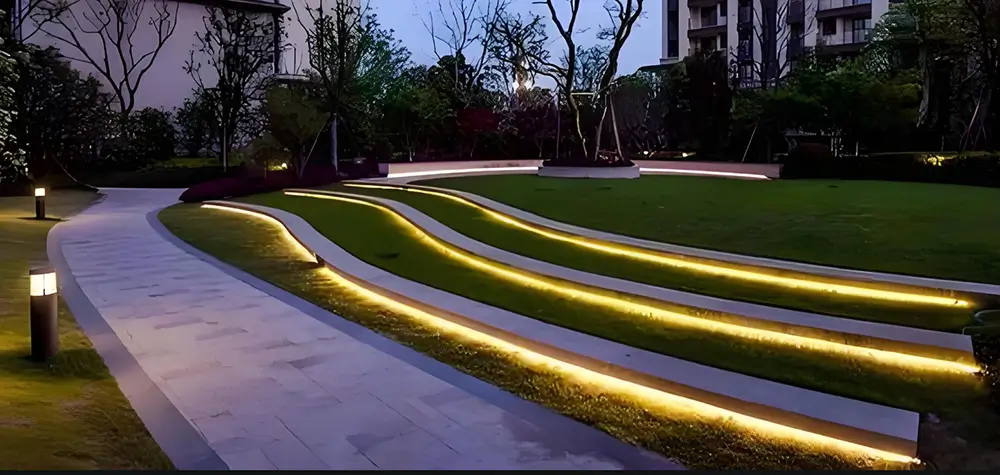
Waterproof LED strip lights are very important for outdoor decoration, mainly for their durability and functionality. Especially in extreme and humid environments such as the outdoors. So how do you choose the right waterproof LED strip lights? We will take an in-depth look at waterproof LED strips light, explain what the ingress protection (IP) rating means and the different ways to achieve different levels of waterproofing. We will also look at common materials used for waterproofing and provide important tips for using these lights effectively in wet environments.
Understanding IP Ratings
When discussing choosing the right waterproof LED strip lights, it is crucial to understand the IP rating in detail. The IP rating (Ingress Protection Rating) is an international standard that measures the protection of a device’s housing against the ingress of solid objects and liquids. IP, the first digit indicates dustproof, and the second digit indicates waterproof. For example, an IP68 rating indicates that the light strip resists dust completely and can be immersed in more than 1 meter of water. Here is a breakdown of some common LED light strip IP ratings:

IP rating structure
The first number (0-6): indicates the level of protection against solid objects (such as dust, sand, etc.).
The second number (0-9): indicates the level of protection against liquids (such as water, oil, etc.).
For example, IP65 is a common IP rating used both indoors and outdoors. It indicates that the device resists dust completely (6) and is protected against water jets from all directions (5).
Waterproof LED Strips Lights IP Rating
The official nature of IP terminology often confuses many people. We will analyse the waterproof level of LED light strips and the outdoor installation scenarios.
- IP20: Not waterproof. For use in dry indoor locations only.
- IP65: Dustproof, limited protection against water splashes from any direction. Suitable for some covered outdoor areas. Recommended for use in covered areas indoors or outdoors.
- IP67: Dustproof and waterproof, recommended for use in wet indoor and outdoor locations, but not recommended for immersion in water.
- IP68: Dustproof, waterproof and fully submersible in water (depth varies by manufacturer, and confirm in advance if it can be placed for underwater lighting). Ideal for underwater applications in swimming pools and aquariums.
When Do You Need Waterproof LED Strips Light?
The uses of waterproof LED strips are extensive. Because it can not only provide lighting but also withstand the test of various harsh environments.

Outdoor landscape
The outdoor environment is highly variable and typically experiences weather conditions such as rain, snow, and bad weather. You can use waterproof LED strips for outdoor landscape lighting, including gardens, courtyards, roads, building exteriors, and signboards, all of which benefit from waterproof LED strips.
Bathroom and kitchen
Waterproof LED strips can be installed in bathrooms and kitchens. This is the area in the home that is most exposed to water, and moisture and water splashing are common phenomena. Especially around mirrors, beside bathtubs, and at the bottom of cabinets. It not only adds beauty to the space but also maintains good performance in high-humidity environments.
Swimming pools and fountains
Waterproof LED light strips can be installed in swimming pools and fountains, but you need to choose IP68 neon tubes specifically for swimming pools. These places are in direct contact with water, and ordinary light strips cannot work properly in such environments. Therefore, IP68 neon tubes are one of the best choices for swimming pools and underwater lighting. About swimming pool lighting, pls read How To Choose LED Neon Flex Lights For Swimming Pool?
On-board applications
Marine applications, such as ships, docks, and offshore platforms, also require waterproof LED light strips. These environments expose the light strips to salt water, moisture, and extreme weather conditions for extended periods, demanding higher durability. Therefore, designers create waterproof LED light strips to resist not only water but also corrosive substances, making them suitable for harsh marine environments.
Commercial lighting
Outdoor billboards, open-air restaurants, and outdoor event venues all require waterproof LED light strips to ensure that the lighting equipment operates normally in various weather conditions. The high brightness, low energy consumption and durability of waterproof LED light strips make them an ideal choice for commercial applications.
People widely use waterproof LED light strips in various situations where they need to deal with environmental factors like moisture and rain. However, it is important to choose the right waterproof LED light strip to ensure that the lighting equipment can operate for a long time, safely and stably in any environment.
What are Waterproof LED Strips Light with Different IP Ratings Made Of?
Let’s unlock what the raw materials of waterproof LED light strips with different IP levels are and how to ensure their waterproof properties.
Silicone Coating
Manufacturers apply a thin layer of silicone directly to the LED strip to provide basic waterproofing against splashes and light rain (typically IP65). This protection is primarily intended for indoor and wet locations.
Silicone Tubing
The LED strip is encased in a clear, flexible silicone tube for better protection against water jets and dust (typically IP67). This option provides good LED visibility and is ideal for outdoor patios and soffits.
Heat Shrink Tubing
Cover the LED light strip with shrinkable plastic tubing that forms a tight seal when heated. Heat shrink tubing provides strong protection against dust and water, suitable for indoor and wet locations.
Fully Silicone Encased
Manufacturers fully encapsulate the LED light strip in silicone, creating a waterproof and dustproof barrier (IP68). The fully silicone-encapsulated light strip works well for outdoor installations, including garden lighting that may be exposed to heavy rain or splashing water.
Nano-coating
They coat LED light strips with a microscopic hydrophobic layer to protect against water and dust (usually IP65).This coating is very thin and maintains good light visibility, but may not be as durable as a full housing.
Waterproof LED Strips Light: Comprehensive Comparison
Now that you understand the different waterproofing methods and materials, here’s a detailed comparison of six common waterproof LED strip light types:
| Type | IP Rating | Waterproofing Method | Advantages | Disadvantages | Applications |
| IP65 – Silicone Coating | IP65 | A thin layer of silicone was applied to the strip | Inexpensive, easy to install | Low level of protection, not suitable for heavy rain or submersion | Bathrooms, kitchens (humid environment) |
| IP67 – Silicone Tube | IP67 | Encased in a clear, flexible silicone tube | Good water and dust resistance, visible LEDs | May not be as flexible for curved surfaces | Outdoor, rainewater environment |
| IP65H – Heat Shrink Tube | IP65 | Heat-activated tube shrunk over the strip | Good water and dust resistance, durable | Can obscure LEDs, less flexible for curves | Indoor, humid environment |
| IP68 – Full Silicone Encasement | IP68 | Completely encased in silicone resin | Highest level of water and dust protection, submersible | More expensive, less flexible | Underwater applications, harsh environments |
| IP67 – Nano-coating | IP65 | Microscopic hydrophobic layer applied to the strip | Very thin, maintains light visibility | May not be as durable as full encasement | Indoor, humid environment |
Conclusion
Waterproof LED strip lights can provide ambient lighting in a variety of wet and outdoor environments. By understanding the different waterproofing methods and the corresponding IP ratings, you can choose the right LED light strip for your needs. Whether you are lighting up a garden, kitchen or underwater facility, there is a waterproofing method that suits your requirements. We are an LED strip lights supplier, please consult if you have any needs.
